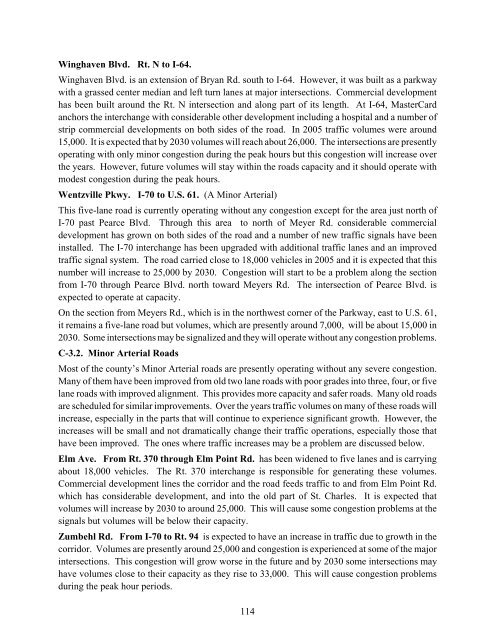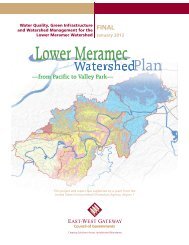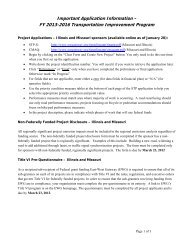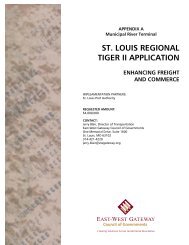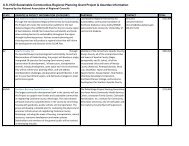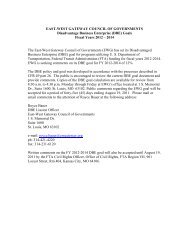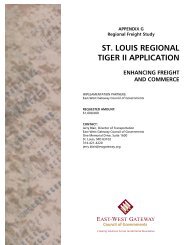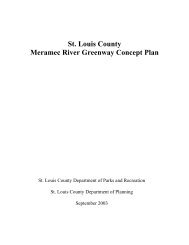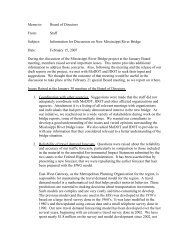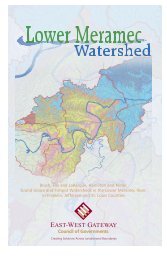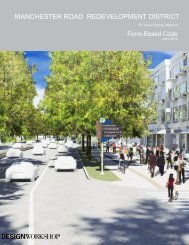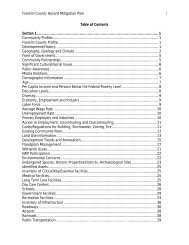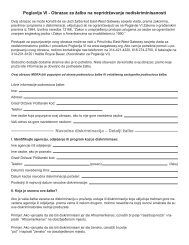St. Charles County Transportation Plan 2030 - East-West Gateway ...
St. Charles County Transportation Plan 2030 - East-West Gateway ...
St. Charles County Transportation Plan 2030 - East-West Gateway ...
Create successful ePaper yourself
Turn your PDF publications into a flip-book with our unique Google optimized e-Paper software.
Winghaven Blvd. Rt. N to I-64.<br />
Winghaven Blvd. is an extension of Bryan Rd. south to I-64. However, it was built as a parkway<br />
with a grassed center median and left turn lanes at major intersections. Commercial development<br />
has been built around the Rt. N intersection and along part of its length. At I-64, MasterCard<br />
anchors the interchange with considerable other development including a hospital and a number of<br />
strip commercial developments on both sides of the road. In 2005 traffic volumes were around<br />
15,000. It is expected that by <strong>2030</strong> volumes will reach about 26,000. The intersections are presently<br />
operating with only minor congestion during the peak hours but this congestion will increase over<br />
the years. However, future volumes will stay within the roads capacity and it should operate with<br />
modest congestion during the peak hours.<br />
Wentzville Pkwy. I-70 to U.S. 61. (A Minor Arterial)<br />
This five-lane road is currently operating without any congestion except for the area just north of<br />
I-70 past Pearce Blvd. Through this area to north of Meyer Rd. considerable commercial<br />
development has grown on both sides of the road and a number of new traffic signals have been<br />
installed. The I-70 interchange has been upgraded with additional traffic lanes and an improved<br />
traffic signal system. The road carried close to 18,000 vehicles in 2005 and it is expected that this<br />
number will increase to 25,000 by <strong>2030</strong>. Congestion will start to be a problem along the section<br />
from I-70 through Pearce Blvd. north toward Meyers Rd. The intersection of Pearce Blvd. is<br />
expected to operate at capacity.<br />
On the section from Meyers Rd., which is in the northwest corner of the Parkway, east to U.S. 61,<br />
it remains a five-lane road but volumes, which are presently around 7,000, will be about 15,000 in<br />
<strong>2030</strong>. Some intersections may be signalized and they will operate without any congestion problems.<br />
C-3.2. Minor Arterial Roads<br />
Most of the county’s Minor Arterial roads are presently operating without any severe congestion.<br />
Many of them have been improved from old two lane roads with poor grades into three, four, or five<br />
lane roads with improved alignment. This provides more capacity and safer roads. Many old roads<br />
are scheduled for similar improvements. Over the years traffic volumes on many of these roads will<br />
increase, especially in the parts that will continue to experience significant growth. However, the<br />
increases will be small and not dramatically change their traffic operations, especially those that<br />
have been improved. The ones where traffic increases may be a problem are discussed below.<br />
Elm Ave. From Rt. 370 through Elm Point Rd. has been widened to five lanes and is carrying<br />
about 18,000 vehicles. The Rt. 370 interchange is responsible for generating these volumes.<br />
Commercial development lines the corridor and the road feeds traffic to and from Elm Point Rd.<br />
which has considerable development, and into the old part of <strong>St</strong>. <strong>Charles</strong>. It is expected that<br />
volumes will increase by <strong>2030</strong> to around 25,000. This will cause some congestion problems at the<br />
signals but volumes will be below their capacity.<br />
Zumbehl Rd. From I-70 to Rt. 94 is expected to have an increase in traffic due to growth in the<br />
corridor. Volumes are presently around 25,000 and congestion is experienced at some of the major<br />
intersections. This congestion will grow worse in the future and by <strong>2030</strong> some intersections may<br />
have volumes close to their capacity as they rise to 33,000. This will cause congestion problems<br />
during the peak hour periods.<br />
114


